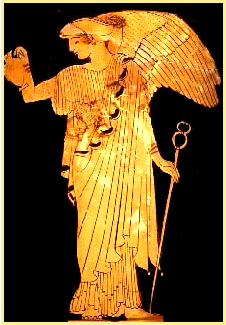Pingala Nadi
 The goddess Iris is the messenger of the Greek gods, and the personification of the rainbow. Like the Kundalini, she is a bridge connecting the human world with the divine. In yoga tradition it is said that union with the divine Self is impossible without the ascent of the Kundalini energy from the sacrum at the base of the spine.
The goddess Iris is the messenger of the Greek gods, and the personification of the rainbow. Like the Kundalini, she is a bridge connecting the human world with the divine. In yoga tradition it is said that union with the divine Self is impossible without the ascent of the Kundalini energy from the sacrum at the base of the spine.
Iris is particularly associated with the supreme goddess Hera (Juno), the wife of Zeus. Callimachus portrays Iris as sleeping under Hera’s throne. The throne of the Goddess is the Kundalini (called Merkabah in Hebrew).
It was sometimes said that Iris’s husband was the west wind, Zephyrus, the gentlest and most welcome of winds. When awakened within the subtle system of the body, the Kundalini is experienced as a gentle, cool breeze.
Her attributes are the caduceus and the vase of water from the river Styx. The caduceus is a symbol of the subtle system through which the Kundalini rises. It consists of a central staff (the Sushumna Nadi of Yoga) entwined by twin serpents (Ida and Pingala Nadis). The Kundalini is described as a serpent-like energy. Both the caduceus and Kundalini are associated with healing. The vase (Indian Kumbha) is a symbol of the Kundalini itself.
In Greek myth, Iris was often summoned to be present at councils of the gods so that she could pour out the Styx water and thereby discover whether or not truth was being told. Kundalini awakening is believed to confer the ability to discriminate truth directly on the nervous system.
Graham Brown
(Photograph: inf.nyme.hu)